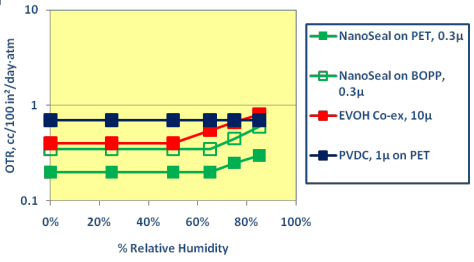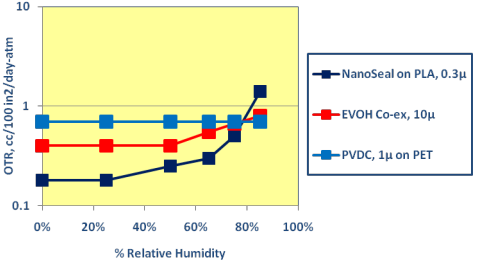Enhanced TDS
Knowde-enriched technical product data sheet
Identification & Functionality
- Chemical Family
- Polymer Name
- Technologies
- Product Families
Features & Benefits
- Labeling Claims
- Materials Features
Applications & Uses
- Markets
- Applications
- Plastics & Elastomers End Uses
- Plastics & Elastomers Processing Methods
- Preferred Application
- Dry mix ingredients
- Confections
- Snacks
- Nuts
- Pet food
- Bakery
- Coffee
- Spice
- Applying NanoSeal Coating
NanoSeal coatings are manufactured as a two-part system: (i) a masterbatch of carrier resin and additives, and (ii) a water slurry of vermiculite platelets. The two parts are mixed gently under ambient conditions just prior to applying the coating. There are several important operating parameters to consider when applying NanoSeal coatings to a film substrate,
- For anchoring the coating on BOPP, a minimum surface energy of 43 dyne-cm is recommended. For PET, BON and PLA, a primer is required for good wet-out on the films and good bond strength.
- Anilox roller design requires that lines per inch (lpi) not exceed 200; cell layout design is not limited: quad, 30º, 60º, open and closed channel have all proven effective.
- A smoothing bar is required when using direct gravure, to align the platelets in the plane of the coatng. Reverse gravure and flexographic applications do not require a smoothing bar.
- NanoSeal coatings have very low solids content (<10%), so adequate drying capacity is required.
- The heat from drying ovens initiates PVOH cross-linking. Curing, and resultant bond strengths, will continue to improve for up to 7 days.
- Because the coating does not heat seal to itself, a sealant layer is required (e.g. polyethylene, polypropylene, etc.), Sealant films can be adhesive laminated directly to the NanoSeal coating, using solvent-based, solventless or water-based adhesive systems.
- A polyethylene sealant film can be extrusion coated onto the NanoSeal coating, using a primer to affect good bonding.
- Solvent-based inks based on nitrocellulose or polyurethanes can be used; water based inks have also been used.
Properties
- Color
- Physical Form
- Physical Properties
Value Units Test Method / Conditions Density 1.4 g/cc - Elongation (at Break, MD, 48) 110.0 % ASTM D822A Elongation (at Break, TD, 48) 90.0 % ASTM D822A Tensile Strength (MD, 48) 32700.0 psi ASTM D822A Tensile Strength (TD, 48) 34100.0 psi ASTM D822A Yield (Nominal, 48) 40000.0 in²/lb - - Typical Properties
Value Units Test Method / Conditions Oxygen Permeability (48, 77°F, 50% RH, 1 ATM) 0.10 - 0.30 cc/100 in²/day ASTM D1434 Water Vapor Transmission Rate (48, 38ºC, 90% RH) 0.90 - 1.00 g/100in²/day ASTM F1249
Technical Details & Test Data
- Technology Overview
NanoSeal coatings are aqueous dispersions of vermiculite platelets in polyvinyl alcohol (PVOH). The platelets are 1-3 nanometers thick and 10-30 microns in breadth, yielding an average aspect ratio (breadth-to-thickness) of ~10,000:1. The platelets are maintained in singularized format when dispersed into the PVOH resin and aligned in the plane of the coating when deposited on a film substrate, such as polyethylene terephthalate (PET), biaxially oriented polypropylene (BOPP), biaxially oriented nylon (BON) or polylactic acid (PLA). The dispersed platelets create a tortuous path for gas molecules, enabling extraordinarily high gas barrier in a very thin layer (0.2 - 0.5 microns dry) with excellent bond strength, clarity and flexibility. The proprietary formulation also improves the moisture-resistance of the PVOH resin. The key technical difference between NanoSeal coatings and past attempts to use nanoclays for barrier enhancement is that in NanoSeal coatings the clay platelets remain in singularized format not only when dispersed in the resin, but also during and after deposition on the film substrates. This achievement presents the tortuous path required for high gas barrier, while enabling the cohesive strength necessary for multi-layered packaging film structures. NanoSeal coatings are applied to flexible films using standard printing and coating equipment (e.g. rotogravure and flexographic presses).
- Oxygen Transmission Rates


- NanoSeal Barrier Coating
